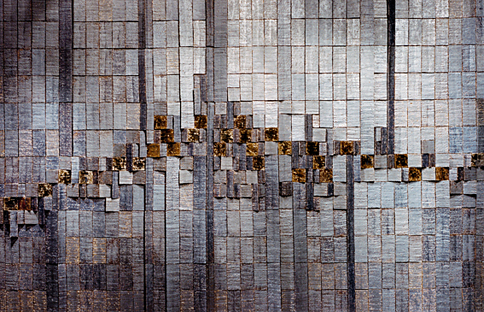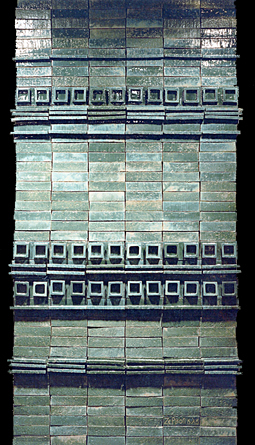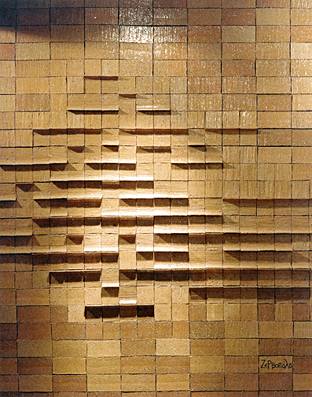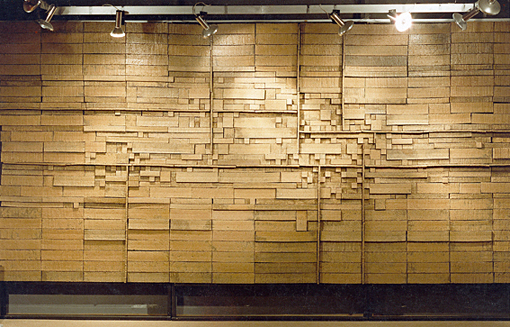THE CERAMIC SCULPTURE OF POPI ZERVOPOULOU
ATTEMPTING TO CONNECT ART WITH LIFE
It is evident that in recent years there are increasing efforts to achieve a greater connection of art with everyday life. The main aim of these attempts is to restore the original functional role of all art forms, which was not that of museum-like display but of a close relation with reality and social life. Painterly trends such as those of art for the people in America and street art in Europe, and the sculptural ways of transforming the urban environment and improving familiar places in various ways, can be seen as typical examples of such efforts. Yet this attempt at a deeper incorporation of artistic creation in life is much more pronounced in ceramic art, both as simple utility pottery and as ceramic sculpture, which is more associated with architecture. Ceramic sculpture comes as a partner of architecture to shape interiors, link exterior surfaces and add a truly new and fruitful connection of art with everyday personal and social life.
This essential and fertile cooperation is showcased by some of the more characteristic works of Popi Zervopoulou–Krouska. A young artist, Zervopoulou had shown her interest in pottery already as a student, and turned more decisively to it after her architectural studies at the University of Thessaloniki. Since 1975, when she graduated, Zervopoulou has been working as both architect and ceramist with the same success. As evidenced in all her works –whether incorporated in large architectural surfaces or rendered in confined interiors, of monumental or small– her aim is to incorporate ceramics into the architectural function and associate them with everyday life and its needs.
The main traits of the plastic vocabulary in all pottery works of Zervopoulou are a geometrical and strictly constructional idiom, the use of combined vertical and horizontal forces, the dominance of the texture of the material and, in some cases, the use of colour to promote the viewer’s contact with the work. Thus in her monochrome works the dominant element is the texture of the material, which leaves viewers with a sense of austerity but also of innerness and security. Building on a purely geometric language, her pottery combines admirably an austere constructivist approach with expressive truth, the certainty of geometric combinations with the warm intimacy of pottery – this combination of earth, water and fire. When they line architectural elements or link large surfaces, as subtle regulatory elements and as strict geometric laws, the ceramic works of Zervopoulou always appear as a rich combination of necessity and freedom. With the austerity of the geometrical vocabulary and the warmth and liveliness of the material, the balance between vertical and horizontal themes and the frequent inclusion of other, always geometrical, shapes – squares, triangles, circles – the work acquires a richly expressive voice and goes beyond expanding the character of an architectural surface and forming an articulated whole. Through a shift of emphasis from one point to another, the vertical or horizontal themes, the dynamic or passive elements, the large units or small sets, through texture or colour, her work acquires astounding expressive capabilities. It becomes a strict organising elements or a purely rhythmic pace, forcing you to follow its course and enriching your life. More than anything else, the ceramic works of Zervopoulou –plastic attainments of a true artist– will never leave viewers uninterested. They establish immediate contact, impose rules, talk about needs and promote the desire for communication with other people and with artistic creations. While never becoming pedantic, this artist seems to have an instinctive ability to transfer her intentions onto the material and turn them into expressive values. And by linking ceramic art with architecture, on both exteriors and interiors, she ends up enriching its expressive potential and broadening art’s contact with life. And this she achieves because hers is an art that stands out for its truth and authenticity, for sticking with the essential and emphasising the functional.
Athens, September 1980 Chrysanthos A. Christou
Professor of Art History, University of Athens
|



